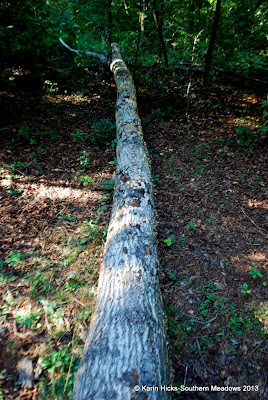The Beauty of Dead and Decaying Wood
If a tree falls in the forest and no one is around to hear it does it still make a sound?
That is a question that has been given much philosophical debate over the ages. Even doing a search on the subject makes for some very interesting reading. The idea that plants can hear and even feel when humans are nearby came up but that is a topic for another post.
This summer two trees fell in our garden. One tree died a year ago. We knew it was going to happen eventually since there was a large cavity at the base of the tree and last summer the leaves turned brown and fell to the ground. But we weren't in a hurry to take it down because the wildlife was enjoying it. The sapsucker woodpeckers had made holes in the trunk, while red-headed and downy woodpeckers picked insects from behind the bark. It was a good source of food for these birds. This tree was also a favorite perching spot for the hawks and vultures and the squirrels climbed it relentlessly. But the time had come where it could no longer stand upright and down it came.
Did the tree make a big noise when it came down? Only the plants, trees and birds know the answer to that question and for now they aren't talking. Amazingly, the tree fell cleanly. It didn't take down any other trees or branches along the way and landed just inches away from a Florida Anise. I am sure if the Florida Anise could talk (and maybe she can) it would have let out a huge sigh of relief.
 |
| Whew! That was a close call! |
It left a great stump which I will incorporate into our landscape design. I love to place plants inside of them and have them flow out of the stump. I can envision some spring blooming native phlox and ferns spilling out of here or perhaps a native vine to serve the pollinators.
Dead and decaying wood is often an overlooked element in the garden. While it may not be included in traditional landscape design it is an important piece when designing a garden for wildlife. At the edge of our woodland garden I used two empty stumps as planters for several native ferns. They benefit from the nutrients of the decaying wood and I like the natural look of these "containers".
There is a cavity at the base of the stump on the left and just the other day I caught a black rat snake poking his head out. They are shy snakes and as soon as he saw me he slithered back inside.
I also use old stumps to hold bird baths, shallow saucers with sand for puddling sites for butterflies or decorative containers. And of course stumps can be a piece of art just by themselves.
The decaying wood of standing or fallen plants is part of Mother Nature's bountiful provisions and is important for wildlife and a healthy ecosystem. It is of great value to fungi, mosses and lichens that already started growing on this tree before it fell.
Skinks will lay their eggs in rotting wood and it is home to beetles and many other insects. Birds feed on these insects and they attract other mammals as well.
Hollow logs provide shelter for a variety of animals including chipmunks, foxes, coyotes and snakes. Doesn't this cavity look inviting? I am sure someone will make use of it this winter.
The death of this tree means the beginning of life for other plants. With the absence of the canopy of this large tree other plants will find their way to this space and fill in the area. Wildlife will use the remains of the tree for shelter and food before the tree returns to the earth from which it came putting nitrogen back into the soil. And soil is one of the most important natural resource on earth. Most life depends on soil for food. It should be treasured and treated with great care!











.png)